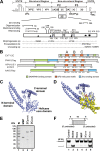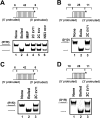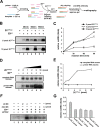Human Enterovirus Nonstructural Protein 2CATPase Functions as Both an RNA Helicase and ATP-Independent RNA Chaperone
- PMID: 26218680
- PMCID: PMC4517893
- DOI: 10.1371/journal.ppat.1005067
Human Enterovirus Nonstructural Protein 2CATPase Functions as Both an RNA Helicase and ATP-Independent RNA Chaperone
Abstract
RNA helicases and chaperones are the two major classes of RNA remodeling proteins, which function to remodel RNA structures and/or RNA-protein interactions, and are required for all aspects of RNA metabolism. Although some virus-encoded RNA helicases/chaperones have been predicted or identified, their RNA remodeling activities in vitro and functions in the viral life cycle remain largely elusive. Enteroviruses are a large group of positive-stranded RNA viruses in the Picornaviridae family, which includes numerous important human pathogens. Herein, we report that the nonstructural protein 2CATPase of enterovirus 71 (EV71), which is the major causative pathogen of hand-foot-and-mouth disease and has been regarded as the most important neurotropic enterovirus after poliovirus eradication, functions not only as an RNA helicase that 3'-to-5' unwinds RNA helices in an adenosine triphosphate (ATP)-dependent manner, but also as an RNA chaperone that destabilizes helices bidirectionally and facilitates strand annealing and complex RNA structure formation independently of ATP. We also determined that the helicase activity is based on the EV71 2CATPase middle domain, whereas the C-terminus is indispensable for its RNA chaperoning activity. By promoting RNA template recycling, 2CATPase facilitated EV71 RNA synthesis in vitro; when 2CATPase helicase activity was impaired, EV71 RNA replication and virion production were mostly abolished in cells, indicating that 2CATPase-mediated RNA remodeling plays a critical role in the enteroviral life cycle. Furthermore, the RNA helicase and chaperoning activities of 2CATPase are also conserved in coxsackie A virus 16 (CAV16), another important enterovirus. Altogether, our findings are the first to demonstrate the RNA helicase and chaperoning activities associated with enterovirus 2CATPase, and our study provides both in vitro and cellular evidence for their potential roles during viral RNA replication. These findings increase our understanding of enteroviruses and the two types of RNA remodeling activities.
Conflict of interest statement
The authors have declared that no competing interests exist.
Figures











Similar articles
-
Human Norovirus NS3 Has RNA Helicase and Chaperoning Activities.J Virol. 2018 Feb 12;92(5):e01606-17. doi: 10.1128/JVI.01606-17. Print 2018 Mar 1. J Virol. 2018. PMID: 29237842 Free PMC article.
-
Antiviral Peptides Targeting the Helicase Activity of Enterovirus Nonstructural Protein 2C.J Virol. 2021 May 24;95(12):e02324-20. doi: 10.1128/JVI.02324-20. Print 2021 May 24. J Virol. 2021. PMID: 33789997 Free PMC article.
-
The nonstructural protein 2C of Coxsackie B virus has RNA helicase and chaperoning activities.Virol Sin. 2022 Oct;37(5):656-663. doi: 10.1016/j.virs.2022.05.004. Epub 2022 May 16. Virol Sin. 2022. PMID: 35589079 Free PMC article.
-
[Advances in functional studies of nonstructural proteins and development of antiviral agents for enterovirus 71].Yao Xue Xue Bao. 2011 Jul;46(7):753-61. Yao Xue Xue Bao. 2011. PMID: 22010343 Review. Chinese.
-
Combating enterovirus replication: state-of-the-art on antiviral research.Biochem Pharmacol. 2012 Jan 15;83(2):185-92. doi: 10.1016/j.bcp.2011.08.016. Epub 2011 Aug 26. Biochem Pharmacol. 2012. PMID: 21889497 Review.
Cited by
-
Nucleotide triphosphatase and RNA chaperone activities of murine norovirus NS3.J Gen Virol. 2018 Nov;99(11):1482-1493. doi: 10.1099/jgv.0.001151. Epub 2018 Sep 28. J Gen Virol. 2018. PMID: 30265237 Free PMC article.
-
Mutations in VP0 and 2C Proteins of Duck Hepatitis A Virus Type 3 Attenuate Viral Infection and Virulence.Vaccines (Basel). 2019 Sep 11;7(3):111. doi: 10.3390/vaccines7030111. Vaccines (Basel). 2019. PMID: 31514454 Free PMC article.
-
Recent Progress on Functional Genomics Research of Enterovirus 71.Virol Sin. 2019 Feb;34(1):9-21. doi: 10.1007/s12250-018-0071-9. Epub 2018 Dec 14. Virol Sin. 2019. PMID: 30552635 Free PMC article. Review.
-
Enterovirus A71 antivirals: Past, present, and future.Acta Pharm Sin B. 2022 Apr;12(4):1542-1566. doi: 10.1016/j.apsb.2021.08.017. Epub 2021 Aug 20. Acta Pharm Sin B. 2022. PMID: 35847514 Free PMC article.
-
Fluoxetine Inhibits Enterovirus Replication by Targeting the Viral 2C Protein in a Stereospecific Manner.ACS Infect Dis. 2019 Sep 13;5(9):1609-1623. doi: 10.1021/acsinfecdis.9b00179. Epub 2019 Jul 31. ACS Infect Dis. 2019. PMID: 31305993 Free PMC article.
References
Publication types
MeSH terms
Substances
LinkOut - more resources
Full Text Sources
Other Literature Sources

